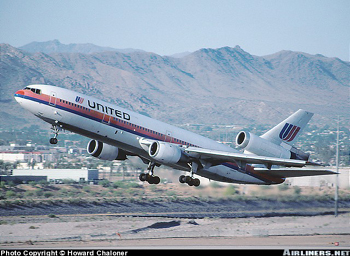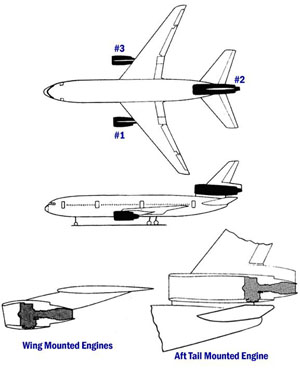McDonnell Douglas D-10
United Airlines Flight 232, N1819U
Sioux City, Iowa
July 19, 1989

Photo copyright Howard Chaloner - used with permission
United Airlines (UAL) Flight 232, a McDonnell Douglas DC-10-10, was a scheduled passenger flight from Stapleton International Airport in Denver, Colorado to Philadelphia, Pennsylvania, with an en route stop in Chicago, Illinois. On July 19, 1989, at 14:09 Central Daylight Time (CDT), Flight 232 departed Denver with 285 passengers and 11 crewmembers on board.
About 1 hour and 7 minutes after takeoff (at approximately 15:16 CDT) the flight crew heard a loud bang followed by vibration and shuddering of the airframe. The flight crew checked the engine instruments and determined that the No. 2 engine (tail-mounted) had failed, and they initiated the engine shutdown checklist. While performing the shutdown checklist, the flight crew noted that the aircraft's normal system hydraulic pressure and quantity gauges indicated zero. The No. 2 engine failure had been caused by a catastrophic uncontained fan disk burst that resulted in engine debris damaging the aircraft's three hydraulic systems that were located in the tail section of the aircraft.
The airplane was minimally controllable via the use of asymmetric thrust control. The crew managed to maneuver the airplane to the vicinity of Sioux City, Iowa. At 16:00 CDT, after being cleared to land at Sioux Gateway Airport in Sioux City, Iowa, the airplane experienced a crash landing while attempting to land on runway 22. There were 111 fatalities, 47 serious, and 125 minor injuries from this accident.
Accident Overview
United Airlines (UAL) Flight 232, a McDonnell Douglas DC-10-10, was a scheduled passenger flight from Stapleton International Airport in Denver, Colorado to Philadelphia, Pennsylvania, with an en route stop in Chicago, Illinois. On July 19, 1989, at 14:09 CDT, Flight 232 departed Denver with 285 passengers and 11 crewmembers on board.
History of Flight

The takeoff and en route climb to a planned cruising altitude of 37,000 feet were uneventful. About 1 hour and 7 minutes after takeoff (at approximately 15:16 CDT) the flight crew heard a loud bang followed by vibration and shuddering of the airframe. The flight crew noted from the engine instruments that the No. 2 engine (tail-mounted) had failed, and they initiated the engine shutdown checklist. While performing the shutdown checklist, the flight crew noted that the aircraft's normal system hydraulic pressure and quantity gauges indicated zero.
The first officer was flying the aircraft at the time of engine failure and advised the captain that he could not control the aircraft, which began a right descending turn. The captain took control of the aircraft and confirmed that it did not respond to control inputs. He then reduced thrust on the No. 1 engine, which resulted in the aircraft rolling to a wings-level attitude. The flight crew deployed the air-driven generator that powers the No. 1 auxiliary hydraulic pump; however, this action did not restore hydraulic power to the aircraft.
At 15:20 CDT, the flight crew radioed Minneapolis Air Route Traffic Control Center (ARTCC) and requested emergency assistance and vectors to the nearest airport. The ARTCC gave the flight crew vectors for the Sioux Gateway Airport in Sioux City, Iowa.
The passengers were informed of the engine failure, and the flight attendants were told to prepare the aircraft for an emergency landing. An off-duty UAL DC-10 training check airman, who was seated in the passenger cabin, came forward to the flight deck to assist the flight crew at approximately 15:29 CDT.
